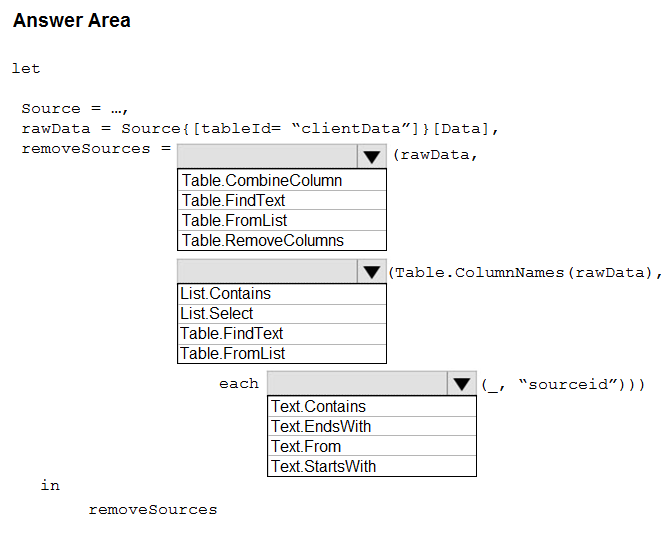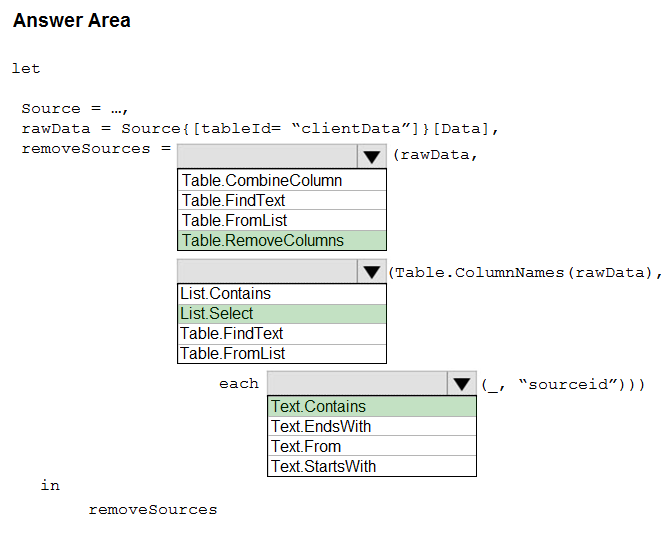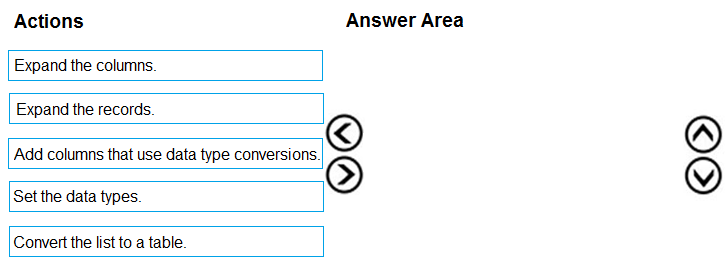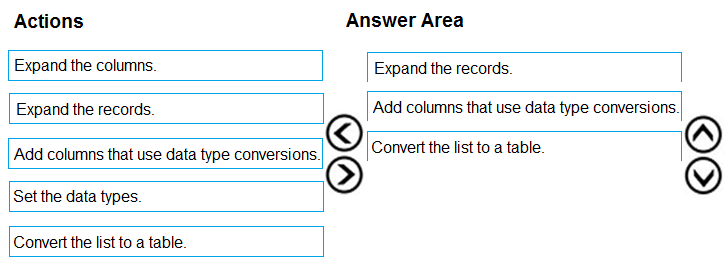Microsoft DA-100 Exam Practice Questions (P. 2)
- Full Access (94 questions)
- One Year of Premium Access
- Access to one million comments
- Seamless ChatGPT Integration
- Ability to download PDF files
- Anki Flashcard files for revision
- No Captcha & No AdSense
- Advanced Exam Configuration
Question #6
HOTSPOT -
You have an API that returns more than 100 columns. The following is a sample of column names.
✑ client_notified_timestamp
✑ client_notified_source
✑ client_notified_sourceid
✑ client_notified_value
✑ client_responded_timestamp
✑ client_responded_source
✑ client_responded_sourceid
✑ client_responded_value
You plan to include only a subset of the returned columns.
You need to remove any columns that have a suffix of sourceid.
How should you complete the Power Query M code? To answer, select the appropriate options in the answer area.
NOTE: Each correct selection is worth one point.
Hot Area:

You have an API that returns more than 100 columns. The following is a sample of column names.
✑ client_notified_timestamp
✑ client_notified_source
✑ client_notified_sourceid
✑ client_notified_value
✑ client_responded_timestamp
✑ client_responded_source
✑ client_responded_sourceid
✑ client_responded_value
You plan to include only a subset of the returned columns.
You need to remove any columns that have a suffix of sourceid.
How should you complete the Power Query M code? To answer, select the appropriate options in the answer area.
NOTE: Each correct selection is worth one point.
Hot Area:

Correct Answer:

Box 1: Table.RemoveColumns -
When you do ג€Remove Columnsג€ Power Query uses the Table.RemoveColumns function
Box 2: List.Select -
Get a list of columns.
Box 3: Text.Contains -
Example code to remove columns with a slash (/):
let
Source = Excel.Workbook(File.Contents("C: Source"), null, true),
#"1_Sheet" = Source{[Item="1",Kind="Sheet"]}[Data],
#"Promoted Headers" = Table.PromoteHeaders(#"1_Sheet", [PromoteAllScalars=true]),
// get columns which contains any slash among values
ColumnsToRemove =
List.Select(
// get a list of all columns
Table.ColumnNames(#"Promoted Headers"),
(columnName) =>
let
// get all values of a columns
ColumnValues = Table.Column(#"Promoted Headers", columnName),
// go through values and stop when you find the first occurence of a text containing a slash
// if there is a value with a slash, return true else false
ContainsSlash = List.AnyTrue(List.Transform(ColumnValues, each Text.Contains(_, "/"))) in
ContainsSlash -
),
// remove columns
Result = Table.RemoveColumns(#"Promoted Headers", ColumnsToRemove) in
Result -
Reference:
https://community.powerbi.com/t5/Power-Query/Remove-columns-containing-a-certain-value/td-p/759657

Box 1: Table.RemoveColumns -
When you do ג€Remove Columnsג€ Power Query uses the Table.RemoveColumns function
Box 2: List.Select -
Get a list of columns.
Box 3: Text.Contains -
Example code to remove columns with a slash (/):
let
Source = Excel.Workbook(File.Contents("C: Source"), null, true),
#"1_Sheet" = Source{[Item="1",Kind="Sheet"]}[Data],
#"Promoted Headers" = Table.PromoteHeaders(#"1_Sheet", [PromoteAllScalars=true]),
// get columns which contains any slash among values
ColumnsToRemove =
List.Select(
// get a list of all columns
Table.ColumnNames(#"Promoted Headers"),
(columnName) =>
let
// get all values of a columns
ColumnValues = Table.Column(#"Promoted Headers", columnName),
// go through values and stop when you find the first occurence of a text containing a slash
// if there is a value with a slash, return true else false
ContainsSlash = List.AnyTrue(List.Transform(ColumnValues, each Text.Contains(_, "/"))) in
ContainsSlash -
),
// remove columns
Result = Table.RemoveColumns(#"Promoted Headers", ColumnsToRemove) in
Result -
Reference:
https://community.powerbi.com/t5/Power-Query/Remove-columns-containing-a-certain-value/td-p/759657
send
light_mode
delete
Question #7
DRAG DROP -
You are building a dataset from a JSON file that contains an array of documents.
You need to import attributes as columns from all the documents in the JSON file. The solution must ensure that date attributes can be used as date hierarchies in
Microsoft Power BI reports.
Which three actions should you perform in sequence? To answer, move the appropriate actions from the list of actions to the answer area and arrange them in the correct order.
Select and Place:

You are building a dataset from a JSON file that contains an array of documents.
You need to import attributes as columns from all the documents in the JSON file. The solution must ensure that date attributes can be used as date hierarchies in
Microsoft Power BI reports.
Which three actions should you perform in sequence? To answer, move the appropriate actions from the list of actions to the answer area and arrange them in the correct order.
Select and Place:

Correct Answer:

Step 1: Expand the records.
First Open Power BI desktop and navigate to Power Query, import the JSON file, then load the data, click on the record to expand it and to see the record and list.
Step 2: Add columns that use data type conversions.
Step 3: Convert the list to a table

Step 1: Expand the records.
First Open Power BI desktop and navigate to Power Query, import the JSON file, then load the data, click on the record to expand it and to see the record and list.
Step 2: Add columns that use data type conversions.
Step 3: Convert the list to a table
send
light_mode
delete
Question #8
You import two Microsoft Excel tables named Customer and Address into Power Query. Customer contains the following columns:
✑ Customer ID
✑ Customer Name
✑ Phone
✑ Email Address
✑ Address ID
Address contains the following columns:
✑ Address ID
✑ Address Line 1
✑ Address Line 2
✑ City
✑ State/Region
✑ Country
✑ Postal Code
The Customer ID and Address ID columns represent unique rows.
You need to create a query that has one row per customer. Each row must contain City, State/Region, and Country for each customer.
What should you do?
✑ Customer ID
✑ Customer Name
✑ Phone
✑ Email Address
✑ Address ID
Address contains the following columns:
✑ Address ID
✑ Address Line 1
✑ Address Line 2
✑ City
✑ State/Region
✑ Country
✑ Postal Code
The Customer ID and Address ID columns represent unique rows.
You need to create a query that has one row per customer. Each row must contain City, State/Region, and Country for each customer.
What should you do?
- AMerge the Customer and Address tables.Most Voted
- BTranspose the Customer and Address tables.
- CGroup the Customer and Address tables by the Address ID column.
- DAppend the Customer and Address tables.
Correct Answer:
A
There are two primary ways of combining queries: merging and appending.
✑ When you have one or more columns that you'd like to add to another query, you merge the queries.
✑ When you have additional rows of data that you'd like to add to an existing query, you append the query.
Reference:
https://docs.microsoft.com/en-us/power-bi/connect-data/desktop-shape-and-combine-data
A
There are two primary ways of combining queries: merging and appending.
✑ When you have one or more columns that you'd like to add to another query, you merge the queries.
✑ When you have additional rows of data that you'd like to add to an existing query, you append the query.
Reference:
https://docs.microsoft.com/en-us/power-bi/connect-data/desktop-shape-and-combine-data
send
light_mode
delete
Question #9
You have the following three versions of an Azure SQL database:
✑ Test
✑ Production
✑ Development
You have a dataset that uses the development database as a data source.
You need to configure the dataset so that you can easily change the data source between the development, test, and production database servers from powerbi.com.
Which should you do?
✑ Test
✑ Production
✑ Development
You have a dataset that uses the development database as a data source.
You need to configure the dataset so that you can easily change the data source between the development, test, and production database servers from powerbi.com.
Which should you do?
- ACreate a JSON file that contains the database server names. Import the JSON file to the dataset.
- BCreate a parameter and update the queries to use the parameter.Most Voted
- CCreate a query for each database server and hide the development tables.
- DSet the data source privacy level to Organizational and use the ReplaceValue Power Query M function.
Correct Answer:
D
With privacy level settings, you can specify an isolation level that defines the degree that one data source must be isolated from other data sources.
An Organizational data source limits the visibility of a data source to a trusted group of people. An Organizational data source is isolated from all Public data sources, but is visible to other Organizational data sources.
Reference:
https://docs.microsoft.com/en-us/power-bi/admin/desktop-privacy-levels
D
With privacy level settings, you can specify an isolation level that defines the degree that one data source must be isolated from other data sources.
An Organizational data source limits the visibility of a data source to a trusted group of people. An Organizational data source is isolated from all Public data sources, but is visible to other Organizational data sources.
Reference:
https://docs.microsoft.com/en-us/power-bi/admin/desktop-privacy-levels
send
light_mode
delete
Question #10
You have a CSV file that contains user complaints. The file contains a column named Logged. Logged contains the date and time each complaint occurred. The data in Logged is in the following format: 2018-12-31 at 08:59.
You need to be able to analyze the complaints by the logged date and use a built-in date hierarchy.
What should you do?
You need to be able to analyze the complaints by the logged date and use a built-in date hierarchy.
What should you do?
- AChange the data type of the Logged column to Date.
- BApply a transformation to extract the last 11 characters of the Logged column and set the data type of the new column to Date.
- CCreate a column by example that starts with 2018-12-31 and set the data type of the new column to Date.Most Voted
- DAdd a conditional column that outputs 2018 if the Logged column starts with 2018 and set the data type of the new column to Whole Number.
Correct Answer:
C
To use a built-in-date hierarchy, you need to set the data type of the new column to Date.
Reference:
https://docs.microsoft.com/en-us/power-bi/create-reports/desktop-add-column-from-example https://www.exceljetconsult.com.ng/home/blog/power-query-split-date-and-time-into-separate-columns/
C
To use a built-in-date hierarchy, you need to set the data type of the new column to Date.
Reference:
https://docs.microsoft.com/en-us/power-bi/create-reports/desktop-add-column-from-example https://www.exceljetconsult.com.ng/home/blog/power-query-split-date-and-time-into-separate-columns/
send
light_mode
delete
All Pages
